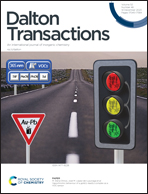Electrocatalytic hydrogen evolution mediated by an organotelluroxane macrocycle stabilized through secondary interactions†‡
Abstract
A discrete liphophilic organotelluroxane macrocycle has been found to catalyse the hydrogen evolution reaction (HER) by proton reduction efficiently. The macrocycle is synthesized via chloride abstraction from bis(p-methoxyphenyl) tellurium dichloride (p-MeOC6H5)2TeCl2 (1) by silver salts AgMX4 (MX4 = BF4−, and ClO4−) resulting in in situ generated di-cationic tetraorganoditelluroxane units; two such units are held together by two weak anions μ2-MX4, bridging to form 12-membered di-cationic macrocycles [((p-MeO-C6H4)2Te)2(μ-O)(μ2-F2BF2)2]2+ (2) and [((p-MeO-C6H4)2Te)2(μ-O)(μ2-O2ClO2)2]2+ (3) stabilized via Te–(μ2-BF4/ClO4), with secondary interactions. The charge is balanced by the presence of two more anions, one above and another below the plane of the macrocycle. Similar reaction at higher temperatures leads to the formation of telluronium salts R3TeX [X = BF4− (4), ClO4− (5)] as a major product. The BF4− anion containing macrocycle and telluronium salt were monitored using 19F NMR. HRMS confirmed the structural stability of all the compounds in the solution state. The organotelluroxane macrocycle 2 has been found to act as an efficient electrocatalyst for proton reduction in an organic medium in the presence of p-toluene sulfonic acid as a protic source.



 Please wait while we load your content...
Please wait while we load your content...